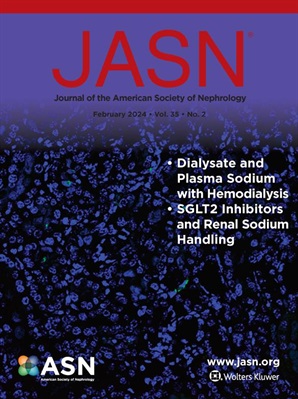通过高分辨率体积EM和机器学习分析照亮肾近端小管结构。
IF 9.4
1区 医学
Q1 UROLOGY & NEPHROLOGY
引用次数: 0
摘要
肾上皮细胞以高容量和高速率进行复杂的载体液体和溶质运输。它们的结构组织反映并实现了这些复杂的生理功能。然而,我们对这些关键细胞功能背后的纳米尺度空间组织和细胞内超微结构的理解仍然有限。为了解决这一知识空白,我们以各向各的分辨率低至4nm,生成并重建了肾近端小管(PT)上皮细胞的广泛电镜数据集。我们采用基于人工智能的分割工具来识别、跟踪和测量所有主要的亚细胞成分。我们用免疫荧光显微镜来补充这一分析,将亚细胞结构与生化功能联系起来。结果我们的超微结构分析显示近端小管细胞具有复杂的膜结合区室组织。根尖内吞系统的特点是深层内陷与密集的根尖小管的吻合网相连,而不是离散结构。内质网显示出不同的结构域:基底外侧区域有开孔片,根尖下区域有较小的不连通簇。我们鉴定、量化和可视化了内质网、质膜、线粒体和根尖内吞室之间的膜接触部位。免疫荧光显微镜显示内质网驻留蛋白在线粒体和质膜界面的不同定位模式。本研究为近端小管细胞组织提供了新的见解,揭示了膜结合细胞器之间的特殊区隔化和意想不到的联系。我们发现了以前未表征的结构,包括线粒体-质膜桥和相互连接的内吞网络,这表明了有效的能量分配、货物处理和结构支撑的机制。4nm和8nm数据集之间的形态学差异表明近端小管中存在亚段特异性特化。这个全面的开源数据集为理解亚细胞结构如何支持健康和疾病中的特殊上皮功能提供了基础。本文章由计算机程序翻译,如有差异,请以英文原文为准。
Illuminating Renal Proximal Tubule Architecture through High-Resolution Volume EM and Machine Learning Analysis.
BACKGROUND
Kidney epithelial cells perform complex vectorial fluid and solute transport at high volumes and rapid rates. Their structural organization both reflects and enables these sophisticated physiological functions. However, our understanding of the nanoscale spatial organization and intracellular ultrastructure that underlies these crucial cellular functions remains limited.
METHODS
To address this knowledge gap, we generated and reconstructed an extensive electron microscopic dataset of renal proximal tubule (PT) epithelial cells at isotropic resolutions down to 4nm. We employed artificial intelligence-based segmentation tools to identify, trace, and measure all major subcellular components. We complemented this analysis with immunofluorescence microscopy to connect subcellular architecture to biochemical function.
RESULTS
Our ultrastructural analysis revealed complex organization of membrane-bound compartments in proximal tubule cells. The apical endocytic system featured deep invaginations connected to an anastomosing meshwork of dense apical tubules, rather than discrete structures. The endoplasmic reticulum displayed distinct structural domains: fenestrated sheets in the basolateral region and smaller, disconnected clusters in the subapical region. We identified, quantified, and visualized membrane contact sites between endoplasmic reticulum, plasma membrane, mitochondria, and apical endocytic compartments. Immunofluorescence microscopy demonstrated distinct localization patterns for endoplasmic reticulum resident proteins at mitochondrial and plasma membrane interfaces.
CONCLUSIONS
This study provides novel insights into proximal tubule cell organization, revealing specialized compartmentalization and unexpected connections between membrane-bound organelles. We identified previously uncharacterized structures, including mitochondria-plasma membrane bridges and an interconnected endocytic meshwork, suggesting mechanisms for efficient energy distribution, cargo processing and structural support. Morphological differences between 4nm and 8nm datasets indicate subsegment-specific specializations within the proximal tubule. This comprehensive open-source dataset provides a foundation for understanding how subcellular architecture supports specialized epithelial function in health and disease.
求助全文
通过发布文献求助,成功后即可免费获取论文全文。
去求助
来源期刊
CiteScore
22.40
自引率
2.90%
发文量
492
审稿时长
3-8 weeks
期刊介绍:
The Journal of the American Society of Nephrology (JASN) stands as the preeminent kidney journal globally, offering an exceptional synthesis of cutting-edge basic research, clinical epidemiology, meta-analysis, and relevant editorial content. Representing a comprehensive resource, JASN encompasses clinical research, editorials distilling key findings, perspectives, and timely reviews.
Editorials are skillfully crafted to elucidate the essential insights of the parent article, while JASN actively encourages the submission of Letters to the Editor discussing recently published articles. The reviews featured in JASN are consistently erudite and comprehensive, providing thorough coverage of respective fields. Since its inception in July 1990, JASN has been a monthly publication.
JASN publishes original research reports and editorial content across a spectrum of basic and clinical science relevant to the broad discipline of nephrology. Topics covered include renal cell biology, developmental biology of the kidney, genetics of kidney disease, cell and transport physiology, hemodynamics and vascular regulation, mechanisms of blood pressure regulation, renal immunology, kidney pathology, pathophysiology of kidney diseases, nephrolithiasis, clinical nephrology (including dialysis and transplantation), and hypertension. Furthermore, articles addressing healthcare policy and care delivery issues relevant to nephrology are warmly welcomed.

 求助内容:
求助内容: 应助结果提醒方式:
应助结果提醒方式:


